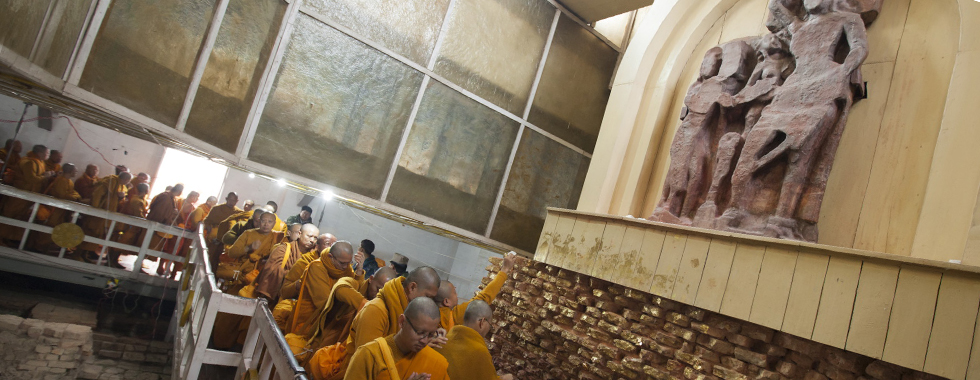Shedding more light on a sacred site
A heavily pregnant Queen Mahamaya was on her way to her parental home from the palace of her husband King Suddodhana at Tilaurakot-Kapilavastu. The palanquin bearing her had travelled for several days covering a distance of nearly 28 kilometres from Kapilavastu when the Queen decided to make a stop at the flower garden at Lumbini. It was here, under the shade of a Sal tree, that she gave birth to Siddhartha Gautama who grew up to become one of the greatest religious teachers the world has known.

Buddhist monks beside the Nativity image within the Maya Devi temple in Lumbini
Maybe accidental, maybe predestined, Lumbini, situated in present-day Nepal, some 300km southwest of the capital Kathmandu, thus became one of the earliest sites of veneration by followers of Gautama Buddha. Now many centuries after the birth of the Siddhartha Gautama, a group of archaeologists has begun to uncover some fascinating new finds that could shed light on early Buddhist activity in the area as well as identify a tree shrine which had occupied pride of place within the Maya Devi temple said to mark the exact place where the Buddha was born.
Among them, Robin Coningham, Professor of Archaeology at Durham University in the United Kingdom, has been in the forefront of the excavations which began in 2011 within the living temple at Lumbini. After nearly two years of intense excavation and analysis, he and a few of his colleagues have pieced together enough facts to give a rare and valuable insight into the structure and character of the earliest Buddhist shrines that pre-date the reign of the great Mauryan Emperor Asoka.
”Our excavations have shown an early delineation of sacred space within the Lumbini locality which shows Buddhist activity in the area before the reign of Asoka,” said Prof. Coningham who was in Sri Lanka last week to present the report on the findings based on

Prof. Robin Coningham
excavations done in the Anuradhapura sacred city area along with Prof. Prishanta Gunawardhana, Head of Archaeology, University of Kelaniya. He also delivered two lectures at the Post Graduate Institute of Archaeology on the findings at Lumbini and Tilaurakot-Kapilavastu in Nepal.
The findings are fascinating because, even though the majority of sites relating to the life of the Buddha have been identified, excavations have failed to expose settings earlier than around the third century BC, the time of the reign of Emperor Asoka who was the greatest patron and propagator of Buddhism and ruled large parts of India about 300 years after the passing away of the Buddha.
At Lumbini, like at other major Buddhist sites, it is the Asokan temple and Pillar marking the place of the birth of the Buddha erected after the Emperor came to pay homage to the site around 245 BC that have been the dominant feature for nearly a century. Like other Buddhist places of veneration, Lumbini was lost to the jungles for hundreds of years with the decline of Buddhism in Northern India and was only accidentally discovered in 1896 by a group of British archaeologists when they found a rubble mound surmounted by a modern shrine to Rupadevi. It was later re-interpreted that Rupadevi was in fact Maya Devi, the mother of the Buddha.
Subsequently temples, monasteries and stupas were unearthed and Lumbini was restored to being a centre for pilgrimage for Buddhists. Its transformation into a living shrine also meant the place was made inaccessible for research for many years.
“Most of the archaeological finds in relation to Buddhism were made during the 19th and 20th century with the latter part of the 20th century witnessing a major increase in pilgrims to Lumbini. What people used since then as evidence to piece together the character of Buddhism is textual,” Prof. Coningham explained. Much changed after Lumbini was declared a World Heritage site in 1997 by the United Nations Educational, Scientific and Cultural Organization (UNESCO), and in 2011, a three-year intervention entitled “Strengthening the Conservation and Management of Lumbini” was launched by the organization to evaluate the presence of early archaeological structures within the Maya Devi temple for which Prof. Coningham and veteran Nepalese archaeologist Kosh Prasad Acharya were selected.
They were allowed to excavate under the Asoka temple foundation and once work started they began to unearth some of the hitherto undiscovered structures that lay buried within the garden of Lumbini for hundreds of years.
“We were able to identify the presence of at least two constructions below the Maya Devi temple built during the time of Emperor Asoka. The oldest was a timber structure dating back to around the 6th century BC and right on top of it, a structure made of large bricks dating to around 3rd century BC. We also found roof tiles and lime plaster during the excavations done in 2011 and 2012 suggesting that part of the structures were covered.”
The remarkable discovery was that the structures had been built exactly on top of one another and each of them had an open area at the centre of the building. They also found holes which are believed to have been dug to secure posts, in the open void below the brick temple.
Prof. Coningham who had based his PhD on extensive field work done in Anuradhapura said he used the findings of one of Sri Lanka’s leading archaeologists Prof. Senaka Bandaranayake for guidance. Bandaranayake, when faced with similar voids at the centre of shrines found in the island, had suggested that they represented bodhigaras or shrines around living trees. Taking a cue from this, Prof. Coningham believes that not only are the investigations at Lumbini providing the first scientifically dated pre-Asokan architecture at a Buddhist shrine but also potentially the first at a tree shrine.
With analysis now underway to ascertain the type of tree to which the shrine was built, Prof. Coningham is optimistic the findings could be indicative of a tree shrine and also point to the fact that ritual activity in Lumbini could have commenced either during or shortly after the life of the Buddha.
With a preliminary report on their findings made public, the Lumbini re-investigation team is preparing a detailed report to be finalized by next year. For Professor Coningham, whose ancestors lived and worked in India for several generations under the British Raj, being able to work in South Asia is a rewarding experience.
“The Buddha’s message of tolerance and nonviolence was used by Emperor Asoka to his great advantage. He realized that without sacrificing human life, property and money, he could conquer lands through nonviolence. It’s the enduring message of the Buddha we uncover with each new discovery we make about his life,” he added.


